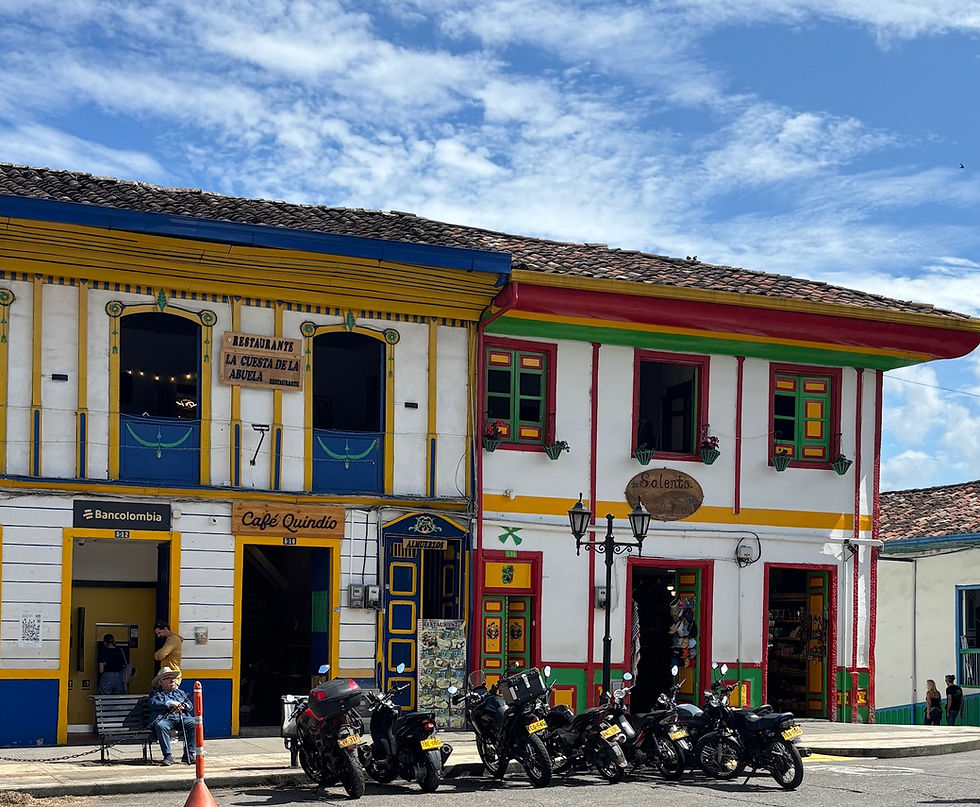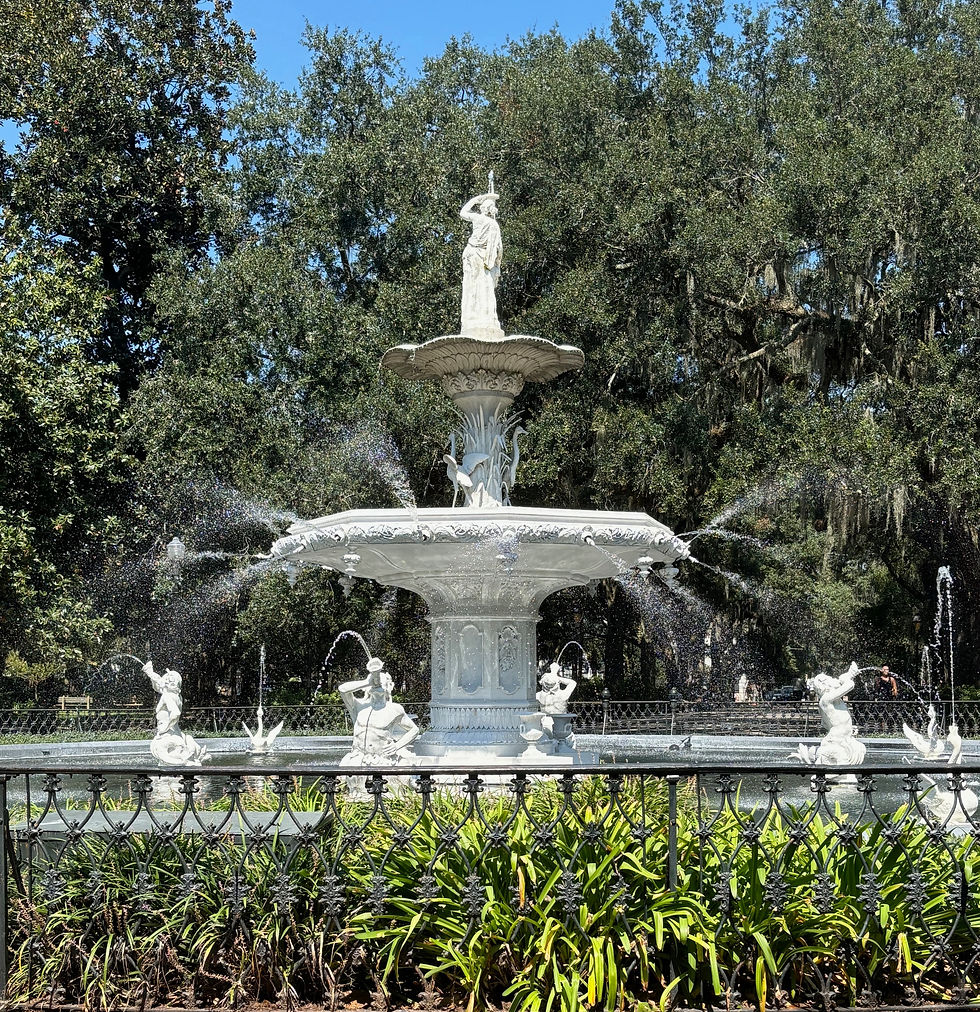Mission Trip to Colombia - Part 2
- Glenni Lorick

- Sep 13
- 4 min read

Thursday morning found us up early again as we prepared for another busy day. Today, however, we didn’t focus on visiting churches; this was our day to explore the coffee region of Colombia. After breakfast, we boarded our bus and headed toward the magical town of Salento. When the filmmakers who created Disney’s Encanto were researching the setting for their enchanted village, they visited Salento and the surrounding Cocora Valley. The colorful architecture of Salento served as inspiration for Encanto.
Enchanting Salento

The drive to Salento was spectacular as we climbed mountains and drove through verdant valleys. The town itself was set amidst rolling hills, so we got lots of exercise wandering through the streets. We had about an hour and a half to explore, shop for souvenirs, and enjoy the beautiful scenery.
Around 11:00, we met up at a famous local restaurant, Donde Laurita. The lunchtime rush hadn’t yet begun, so they were able to seat all 24 of us close together. Trucha (trout) is a local favorite, so I ordered the trout with garlic butter. Even though they served my fish staring at me (it’s typical to serve fish with the entire head – many consider the eyeball a delicacy), it was delicious! Exploring the restaurant and the many unique decorations was almost as fun as the meal itself.
After lunch, we made our way back to the city center's main square, where we met our tour guide, Juan Camilo, who spoke excellent English, having spent a year in the US as an exchange student. He explained the history of Salento and told us about the amazing Wax Palm Trees that grow over 150 feet tall. Then he led us to the jeeps that would take us to a coffee plantation.
Coffee Comes to Life
Years ago in Costa Rica, our family had visited a coffee plantation, but our tour of the Luger Plantation was next level! The name Luger is a combination of the names of the original owners, Lucinda and Gerarldo. Our guide Steven explained the history and process of coffee growing in Quindio. We learned the difference between Arabica and Robusta coffee beans. The Arabica beans make aromatic coffee with sweeter tones. Arabica coffee beans only grow at specific elevations, and the Quindio region of Colombia offers ideal growing conditions.
Steven invited us to grab a hat and follow him out onto the grounds of the plantation, where we saw coffee plants in bloom as well as huge bamboo trees. Shimmying up the hill, he quickly found some ripe coffee beans and picked a handful to show us. He pointed out some beans that had been invaded by a tiny beetle called the Coffee Berry Borer. It lays its eggs in the ripening bean, then the larvae eat the bean. Although these beans still get harvested, the quality of coffee is much lower.

Then Steven showed us how they remove the green coffee beans from the coffee cherries before washing them. The difference in beans affected by the beetle and those that had not been attacked was striking; the unaffected beans were much lighter. Some beans undergo a fermentation process that allows them to have undertones similar to honey. In fact, they call it “honey coffee.” After the drying process, they remove dried husks and the papery layers in a process called “Trillado,” where they use the breeze to blow away the unnecessary parts. Finally, it is time to roast the beans, grind them, and serve them. I’m not much of a coffee drinker, but the Arabica honey coffee Steven served us was truly delicious.
After several hours at the Luger Plantation, we loaded up in the jeeps and went back to town. It was getting late, so we stopped at Los Robles de Quindio, a restaurant on the highway headed back towards Pereira. I shared an amazing Colombian dinner with a friend because I knew it would be too big for me to eat alone!
More Terrific Church Visits
Early Friday morning, we packed our bags, ate breakfast, and loaded everything back onto our bus as we headed toward Armenia and a retreat with 440 ladies! On the way, however, we visited several more churches.

The first church was right there in Pereira. We had a lovely visit with the ladies of the church, but the real highlight was the children of the Colegio Americano, which is attached to the church. Many of the children were in the large open area in the middle of the building, which serves as a gymnasium and a recess yard. They were eager to practice their English with us, and those who were a bit more daring initiated conversation. We answered in English, but when we hit the limit of their English, they were delighted when I began speaking to them in Spanish.
As I headed back to the main church, I was overwhelmed with memories of my son’s graduation from the Colegio Americano in Cali. John Carl was just 16 when the Lord clearly led him to spend his junior year there. They only have 11 grades, so at the end of the year, we went to Cali for his first high school graduation. He was honored by the faculty for his outstanding Christian faith during the ceremony. For some reason, being around the children at the Colegio Americano in Pereira made me extremely emotional as I remembered the thankfulness and joy I felt the night of his graduation.

Our next stop was about 45 minutes away in Cartago, where we met Pastor Michael. The difference between this church and the other larger churches we had seen was striking. But Pastor Michael was excited about what God is doing in their midst as he shared his heart with us. We were honored to bless Pastor Michael with a gift to help his ministry.
Our final visit was about 40 minutes away in Quimbaya, a charming small town. Like the church in Cartago, the Quimbaya church is smaller and more in need of help, which we were honored to provide. We explored the town for a while before heading to a local restaurant for lunch. Once again, I shared lunch with a friend because there was just so much food! After lunch, we boarded our bus once again going to Mahanaim, just outside of Armenia. There we would spend the next 4 days worshipping, fellowshipping, and celebrating the body of Christ!



Comments